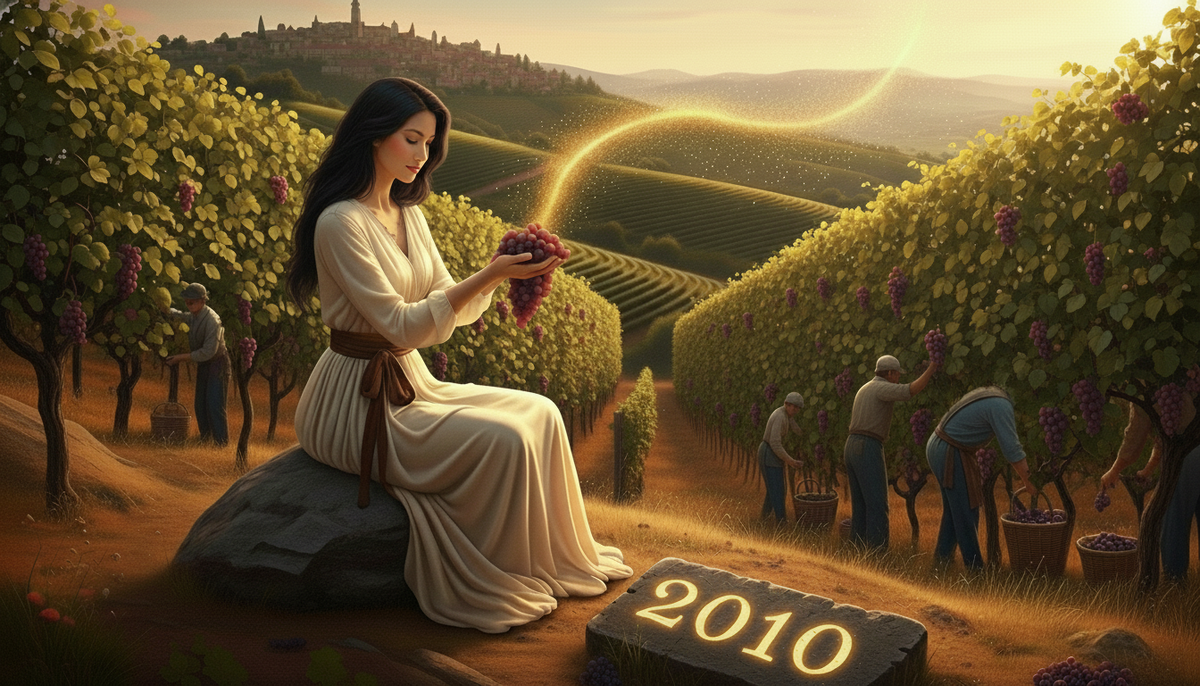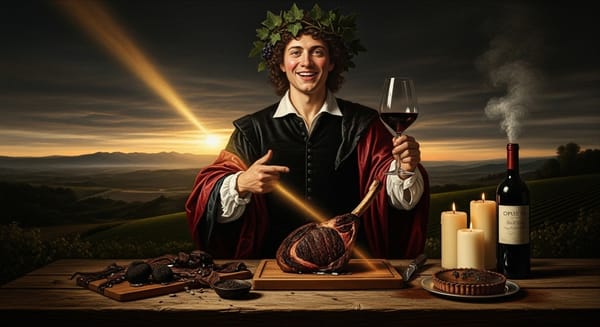2010 Barolo: A Laser Line of Acidity That Defines the Classic Ideal
Barolo 2010: A monumental vintage defined by laser-line acidity and sublime perfume. Learn why this Nebbiolo classic, with its granite-like structure and decades of aging potential, is essential for any serious collector.

I will now apply poetic titles to the existing headings of the Barolo 2010 vintage note, ensuring they are sensory-rich, use imagery of tension/stone/light, and avoid fabric or volume metaphors, in line with the established Chang'e voice.
2010 Barolo: A Laser Line of Acidity That Defines the Classic Ideal
Rose petal sketched in iron dust at dawn—can elegance truly carry a blade?
The Season's Quiet Alchemy: Snowmelt to Electric Night
The Barolo 2010 vintage began with a late, snowy winter, blanketing the Langhe hills and charging the deep soils with plentiful water reserves that proved absolutely vital later in the season. A cool, slow spring followed, unrolling like a green scroll and ensuring an even to mostly even flowering, with some site variation, promising deep concentration without sacrificing grace. Summer was temperate, a steady climb of warmth, but the alchemy arrived with autumn: warm August melted into mild September days, which were critically offset by cool, electric nights—the essential diurnal swing that preserved the Nebbiolo's delicate freshness and aromatic intensity. Growers enjoyed a long, unhurried October window, where the grapes achieved full, dark ripeness on the vine, with picks running from mid-month through early November by elevation. The stakes were high: drawing out the dense, dark ripeness of the decade while ensuring a thrilling tension and structural backbone—capturing perfume with grit.
The Structure's Pledge: Long Life Chiseled in Stone
Is 2010 Barolo worth aging? Absolutely. This vintage stands as a modern reference for classical structure, a harmonious blend of the ripeness seen in 2006 with the vibrant acidity of 2008. The wines possess a rare energy: a vivid, linear acid line and abundant, yet powder-fine tannins. The combination of long hang time, cool night temperatures, and low natural pH (acidity) did more than just ripen the fruit—it sculpted the longevity of the wines, giving them the slow-burn, high-resolution clarity prized by collectors. Where some warm vintages offer muscle, 2010 offers chiseled precision, guaranteeing a marathon run of four decades or more.
Decoding the Glass: Flame, Iron, and the Cool Entry
To taste 2010 is to experience a flame behind crystal—incisive, pure, and intensely focused in the glass. The color is classic garnet, often holding a deep core that catches the autumn saffron light. The aroma is a profound conversation between the sweet and the savory: notes of sour cherry, wild red currant, and bright blood orange are instantly contrasted by the serious, earthy foundations of rose, crushed stone, dark tar, licorice, anise, and a distinct ferrous note of iron filings. On the palate, the entry is limestone-cool, gradually building to a formidable structure. Tannins come from Nebbiolo’s phenolic-rich skins and seeds; grain ranges from chalk-fine to pebble-firm, carrying the fruit into a long, reverberating mineral tail. Nebbiolo stands tall in rose and iron, then speaks in a dialect of tea leaf—complex, aromatic, and deeply territorial.
The Langhe’s Dialects: Soil, Aspect, and Cru Clarity
The Cru Snapshot of 2010 reveals the vintage's site-specific clarity. Serralunga d’Alba, rooted in ancient Helvetian soils, delivered wines of seismic depth and immense power, marked by iron, graphite, and dark fruit that require patience. In Castiglione Falletto, the wines achieve a brilliant equilibrium, weaving red fruit and spicy anise into an intricate lattice of poised tannin. Monforte d’Alba, with its high altitude and firm backbone, expressed intense tension, often showing dark balsam notes of pine and profound savory depth. La Morra, rooted in Tortonian soils, provided the vintage’s most fragrant offerings—ethereal, high-toned, and immediately charming, though with a serious limestone undercurrent promising evolution. Finally, the wines from Barolo (Comune) and Novello found their classic archetype—a seamless blend of cherry, rose, and cedar with beautifully measured weight. The dark horse of 2010 is undeniably the old high parcels of the Ravera cru in Novello; their cool, exposed position magnified the vintage’s signature acidity, creating wines of electric focus that punched far above their perceived status.
Cellar Choices: Shaping the Spirit with Time and Wood
The brilliance of the 2010 vintage lay in the cellar choices that harnessed its innate energy. Winemakers favored lower fermentation temperatures to preserve the Nebbiolo’s volatile aromatics—the rose and red berry lift. The debate between traditionalists and modernists played out in maceration length: Traditional long infusions (25–60 days) sought to gently extract the fine tannins through techniques like cappello sommerso—submerged-cap maceration for gentle extraction—while modernists used controlled rotations over 10–15 days. Crucially, most producers used large, neutral Slavonian botti for aging, favoring surface area (allowing slow oxygen exchange) over imparted flavor. Élèvage length saw 18–36 months in wood depending on producer; 38 months total aging minimum by law. A handful of adventurous growers even experimented with partial whole-cluster for lift and spice. Despite the ripeness, the wines maintained moderate ABV (14%–14.5%), a testament to the long, cool hang time and focus on achieving perfection without excess, always keeping the terroir audible.
The Craftsmanship: Hands That Drew the Line
The best producers 2010 Barolo rewarded focus and gentle handling.
Icons: Giacomo Conterno's Monfortino 2010, bottled later, is rightly a legend, embodying the vintage's deep power and endless arc. Bartolo Mascarello delivered a wine of pure, classical austerity and sublime aromatic lift. Giuseppe Rinaldi’s last great vintage shone with exquisite perfume and penetrating mineral intensity. Vietti Rocche di Castiglione is a perfect snapshot of elegance and spice. Gaja Sperss combined Serralunga's grit with polished finesse.
Value Plays: Brovia’s Barolo commune bottlings offered aromatic complexity and fine tannin at a relative value. Oddero's estate wines are classically proportioned and built to last. Massolino and Fratelli Alessandria both captured the depth and structure of their respective Serralunga and Verduno crus beautifully. Elvio Cogno delivered an early classic from Ravera.
Wild Cards: Cavallotto Bricco Boschis is a coiled spring of power, delivering Castiglione Falletto depth and balance. Luigi Baudana (Baudana & Cerretta) showed striking purity. Trediberri provided a fresh, accessible take on the year's elegance. Fenocchio’s long macerations (often up to 60 days) show the beauty of slow, gentle extraction.
The Slow Unfolding: A Calendar of Revelation
The Barolo 2010 wines, with their vibrant acid and firm structure, are only just entering their first phase of complexity.
Early Charm (Now–2030): Estate Barolos from sandier soils (like some La Morra) and shorter macerations. They benefit greatly from a two-hour decant to open the shy aromatics and smooth the initial firmness.
Sweet Spot (2031–2050): The primary aging window for most cru and comune bottlings. Here, the youthful tension subsides, tannins knit perfectly, and the perfume glows with tertiary notes of rose, leather, earth, and porcini mushroom.
Marathon (2040s and beyond): The titans from Serralunga and Monforte d’Alba, particularly those made by long-maceration traditionalists. This category has the bones for 30–40 years in top bottlings, requiring only a slow-oxygenation (stand-up decant) and will unfold into wines of breathtaking detail and resolution.
Final Reflection
The 2010 Barolo is a truly monumental vintage, delivering on the promise of the Langhe's cold sun and cool grace with spectacular precision. It is defined by its pristine structural architecture, exhibiting both the immense power to age for decades and the aromatic beauty to captivate even in its youth. The perfect tension between the vivid, linear acidity and the fine, abundant tannin ensures that this wine will unfold slowly, offering new complexities with every passing decade. Ultimately, 2010 stands as a pure Nebbiolo mirror, setting the modern standard for the classic Barolo ideal.





